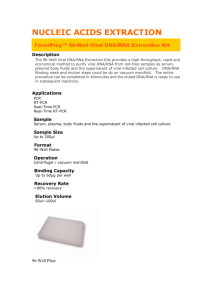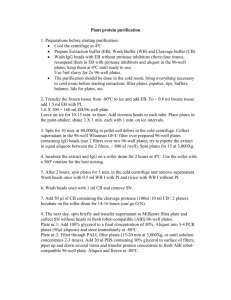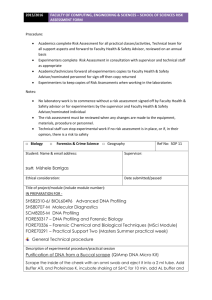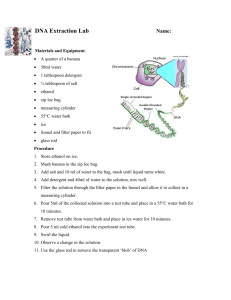ES cell DNA preparation in 96
advertisement
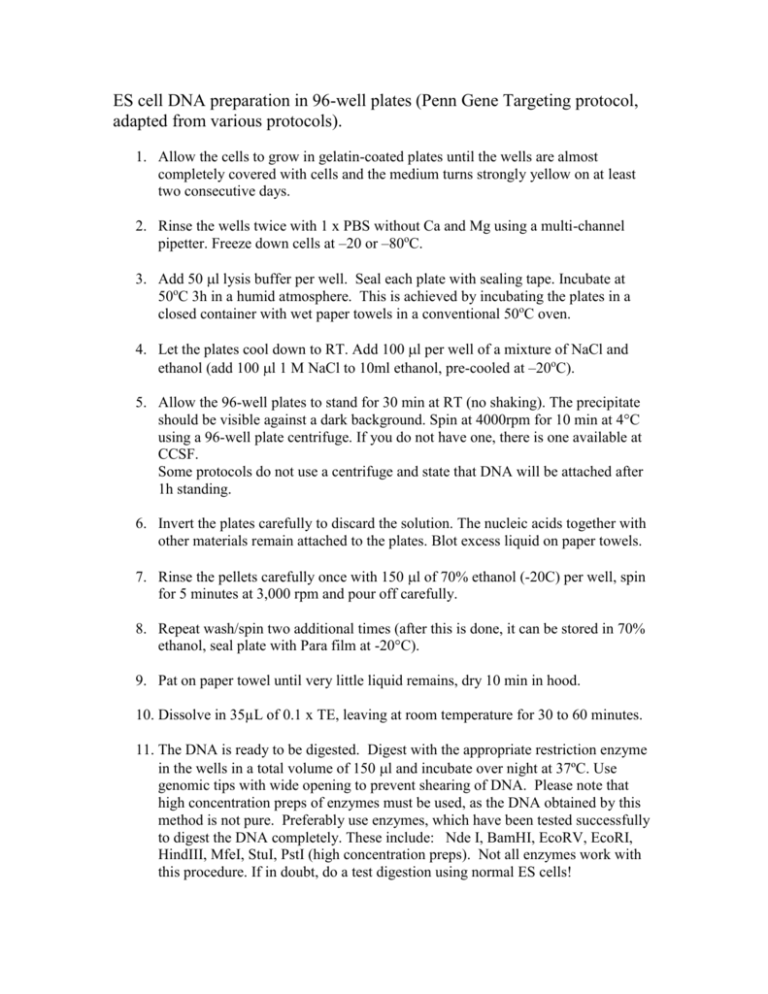
ES cell DNA preparation in 96-well plates (Penn Gene Targeting protocol, adapted from various protocols). 1. Allow the cells to grow in gelatin-coated plates until the wells are almost completely covered with cells and the medium turns strongly yellow on at least two consecutive days. 2. Rinse the wells twice with 1 x PBS without Ca and Mg using a multi-channel pipetter. Freeze down cells at –20 or –80oC. 3. Add 50 l lysis buffer per well. Seal each plate with sealing tape. Incubate at 50oC 3h in a humid atmosphere. This is achieved by incubating the plates in a closed container with wet paper towels in a conventional 50oC oven. 4. Let the plates cool down to RT. Add 100l per well of a mixture of NaCl and ethanol (add 100 l 1 M NaCl to 10ml ethanol, pre-cooled at –20oC). 5. Allow the 96-well plates to stand for 30 min at RT (no shaking). The precipitate should be visible against a dark background. Spin at 4000rpm for 10 min at 4°C using a 96-well plate centrifuge. If you do not have one, there is one available at CCSF. Some protocols do not use a centrifuge and state that DNA will be attached after 1h standing. 6. Invert the plates carefully to discard the solution. The nucleic acids together with other materials remain attached to the plates. Blot excess liquid on paper towels. 7. Rinse the pellets carefully once with 150 l of 70% ethanol (-20C) per well, spin for 5 minutes at 3,000 rpm and pour off carefully. 8. Repeat wash/spin two additional times (after this is done, it can be stored in 70% ethanol, seal plate with Para film at -20°C). 9. Pat on paper towel until very little liquid remains, dry 10 min in hood. 10. Dissolve in 35µL of 0.1 x TE, leaving at room temperature for 30 to 60 minutes. 11. The DNA is ready to be digested. Digest with the appropriate restriction enzyme in the wells in a total volume of 150 l and incubate over night at 37ºC. Use genomic tips with wide opening to prevent shearing of DNA. Please note that high concentration preps of enzymes must be used, as the DNA obtained by this method is not pure. Preferably use enzymes, which have been tested successfully to digest the DNA completely. These include: Nde I, BamHI, EcoRV, EcoRI, HindIII, MfeI, StuI, PstI (high concentration preps). Not all enzymes work with this procedure. If in doubt, do a test digestion using normal ES cells! 12. Precipitate the DNA and re dissolve in a small volume and load on a well of an agarose gel and run the gel overnight for analysis by Southern blot. Genomic tips: Bio-Rad Cat No 223-9312 Sealing Tape: Wallac: Cat No 1450-461 Lysis buffer: 10mM Tris (ph 7.5) 10mM EDTA 10mM NaCl 0.5% (w:v) Sarcosyl or SDS 1mg/ml Proteinase K (add before use) Restriction enzyme buffer: Use buffer known to work optimal for your enzyme And add RNAse A at 50g/ml final concentration.
